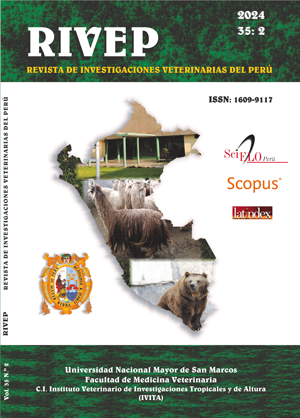Report of infestation by Tunga penetrans (Order: Siphonaptera) in a domestic canine (Canis familiaris) from a rural area of Salta, Argentina
DOI:
https://doi.org/10.15381/rivep.v35i2.27852Keywords:
Tunga penetrans, canine, SaltaAbstract
A case of infestation by Tunga penetrans in a canine from a rural area of the city of Salta (Argentina) is described to provide information to the epidemiology of this disease at a regional level. A skin sample from a three-year-old mixed-breed canine that showed pain when walking was received in the laboratory. In the ventral part of the plantar pad of the left front limb there was a nodular thickening of a light color on its periphery with a dotted center of darker color. The parasitological study showed that it was an infestation by T. penetrans. This report adds to the information already available in the province; However, it is the first documentation of this presentation in canines at a regional level and in a rural area.
Downloads
Downloads
Published
Issue
Section
License
Copyright (c) 2024 Gisela Mariana Tolaba Carrillos, Griselda Noemi Copa, Leandro Hipólito Olmos

This work is licensed under a Creative Commons Attribution 4.0 International License.
AUTHORS RETAIN THEIR RIGHTS:
a. Authors retain their trade mark rights and patent, and also on any process or procedure described in the article.
b. Authors retain their right to share, copy, distribute, perform and publicly communicate their article (eg, to place their article in an institutional repository or publish it in a book), with an acknowledgment of its initial publication in the Revista de Investigaciones Veterinarias del Perú (RIVEP).
c. Authors retain theirs right to make a subsequent publication of their work, to use the article or any part thereof (eg a compilation of his papers, lecture notes, thesis, or a book), always indicating the source of publication (the originator of the work, journal, volume, number and date).










